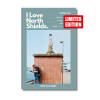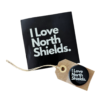By Caroline Oswald
As a young man, my dad gained so much invaluable experience under the supervision of the talented craftsmen at Lambie’s boat yard, Wallsend. This has clearly served him well throughout his following career and life. Whilst still working at the boat yard, Peter started on his second home-built boat, the GP14, another Jack Holt design. My dad and his good friend, Robin Pattison, spent all of their spare time working in his parents’ garage and the boat was completed in around six weeks. The young men and their new boat, called Karin, ended up being published in the local newspaper, and Morison Lambie paid my dad a visit to compliment him on his achievement. They towed the Karin to various locations up the coast as far as Loch Awe, enjoying many happy sailing trips with their friends Norman and Gordon, who also worked at Lambie’s. Peter finally left Lambie’s, applying skills learned in the RAF to become an architectural model maker for Northumberland County Hall and eventually Newcastle City Council. It was an exciting period of city planning at that time and he made the models for many important developments including Cramlington New Town, Eldon Square, Newcastle Quayside, Byker Wall, St James’ Park and the Tyne and Wear Metro line. The complete vast model of Newcastle City Centre that he worked on with his colleague, John (Jack) Laybourne, between 1963 and 2010, is still on display to this day with a plaque at the Civic Centre. He met my mother, Veronica, at a planning department party, they married and moved into a Victorian house in North Shields. The attic was converted into a workshop so he and Jack could complete various private freelance modelling projects. As a child, I remember being fascinated by the large models of towns in our loft, complete with tiny people, cars and trees.
Peter never lost his love of all things nautical. He owned and maintained several boats over the years, sailing for pleasure all around England and Scotland. Around 30 years ago he fulfilled his desire to come up with his own unique boat design and made a scale model from this. His ambition was to eventually build the wooden sailing dinghy full size, and he prepared by filling the house with the necessary materials, including huge planks of wood, much to my mother’s bemusement. Sadly, my mum then became ill and this became the priority for the next few years. After she passed away, the dream of the boat was resurrected. Now in his eighties, my dad cast his mind back to his time at Lambie’s around 60 years ago. He literally used the loft to ‘loft the lines’, and bit by bit the 13-foot Northumbrian lugger began to take shape in his attic. Here he made a set of moulds and set them all up on the building board. This was to produce a full-sized half model to check if the lines were fair. He made the other half resulting in a complete frame, with stem, keel and stern now constructed. The stem was laminated from ash strips and the keel was American white oak. As much as possible, the correct sized scantlings (pieces of timber) were ordered from Percy A. Hudson timber merchant, North Shields. He then faired up (cut and planed) everything by hand. The stringers (the long strips that support the planking) were also hand-steamed into position. The planking followed with 9mm thick marine plywood to BS1088 specification and bronze fasteners. People were amazed and often asked how he proposed to get the boat down from the attic. He actually built it in kit form so that it could be taken apart and moved out in preparation for the next stage of building. The Covid-19 pandemic spurred things on as my dad was categorised as vulnerable and unable to leave the house. A good friend and neighbour, John Hastie, set about building a custom-made boat shed in my dad’s back yard and the project became well underway. Throughout lockdown Peter recreated Lambie’s in his own back yard, repeating the process he had already completed in the attic to assemble the boat permanently.
It was a momentous day when the boat was turned upright for the first time and we could really envisage the impressive vessel to come. It is now nearing completion and has come to life with its beautifully painted colours and oil-treated wood. All that is left to be done is for the bronze fittings (i.e. fairleads, cleats and rowlock plates) to be permanently installed and accessories such as oars to be acquired, ready for the launch. The maiden voyage will be to test stability and balance and to work out if any alterations are needed. In the future a mast with a single balanced lug sail will hopefully be added. Peter has not yet worked out the location or exact logistics of the launch, but he hopes it will be some time this summer around his 89th birthday. The last thing to be added will be the name, Veronica, after my late mother, who enjoyed many years of sailing with my dad before developing a phobia of water in later life. I am hoping I have no such fears as my dad tells me wherever the launch happens, I will definitely be part of the crew. Watch this space to find out whether Veronica can prove her seaworthiness…
If you’ve been captivated by the story so far, get ready for more in the upcoming July issue. Part 3 of the tale promises to unravel even more adventures.














